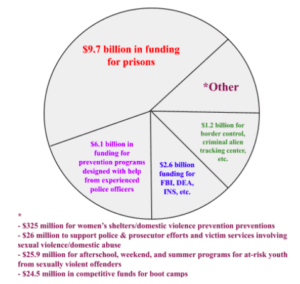Many of us know about the War on Drugs during the 1970s, the era of mass incarceration from mostly low-level offenses, such as the possession of marijuana and the systemic distribution of crack to racially and economically marginalized neighborhoods. “We knew we couldn’t make it illegal to be either against the war or [B]lacks, but by getting the public to associate the hippies with marijuana and [B]lacks with heroin, and then criminalizing both heavily, we could disrupt those communities. We could arrest their leaders, raid their homes, break up their meetings, and vilify them night after night on the evening news. Did we know we were lying about the drugs? Of course, we did,” explained former President Nixon’s assistant, John Ehrlichman in Harper’s Magazine in 1994. Ehrlichman reveals this as Nixon’s strategy during the War on Drugs to dehumanize Blacks, Hispanics, and Latinos. Eventually, Nixon doubled federal spending for local law enforcement, leading to a rise of juvenile arrests by almost 800 percent involving the use of drugs.
But have you heard of the Violent Crime Control and Law Enforcement Act of 1994? How this lengthy 30 billion-dollar crime bill aids the police status quo by dehumanizing people of color?
Before the crime bill came the Omnibus Crime Control and Safe Streets Act of 1968 that received $400 million for law enforcement to “stabilize crime rates,” and the Anti-Drug Abuse Act of 1986 that enacted harsher penalties for federal drug cases, including life imprisonment. From the 1960s to the 1980s, arrests for violent crime rose to 270 percent and continued to increase to 758 violent offenses per 100,000 people in 1991.
Now, the 1994 Crime Bill, written over the course of six years. It was passed by former President Clinton. Side note: President Joe Biden aided in writing this bill, though he claims to have revoked his support.
While this bill contains funds for rehabilitative and preventive programs, the majority of the funds are dedicated to vindictive measures. Look at the statistics:

The 1994 Crime Bill also extended the federal death penalty, constituting mandatory
“three-strikes” life sentences for repeat offenders (even for low-level offenses), authorized adult prosecution of children 13+, and funded 100,000 new police officers.
The death penalty, otherwise known as “a direct descendant of lynching,” was authorized to be used for over 60 new federal offenses in the crime bill. In the five years after the bill’s passing, 74 percent of death penalty recommendations from federal prosecutors were people of color, notably 44 percent Black and 21 percent Hispanic. It’s honestly appalling to think that people hand out recommendations for death sentences like it’s not a person’s life you’re taking away.
More recently, the Trump administration authorized federal prosecutors to track death penalty cases “dealing in extremely large quantities of drugs.” Due to racial profiling and the history of the War on Drugs, “[B]lack people are far more likely than white people to be arrested, charged, convicted, and incarcerated for drug crimes—even though they use and sell drugs at similar rates.” They are also more susceptible to stop-and-frisk: a Fourth Amendment policy allowing police to stop and give a pat-down of someone they suspect is armed or dangerous.
Let’s talk about another big change in the 1994 Crime Bill- mandatory life sentences to people with three or more felony convictions. People of color are more likely to be convicted of crimes by the police. For example, police make more drug arrests in low-income neighborhoods because they are constantly policing those areas. They don’t take into account the lack of resources available to support those with drug problems or the lack of funds to bail them out. This is due to a type of racial management called biopower: the subjugation of a group of people.
So, how does this insinuate the police status quo?
The police status quo is a type of hegemony: “the political, economic, and cultural control of one group over another and allows for distinctions between individuals while simultaneously policing the bodies and militarizing the state borders of those constructed as Others” (Giroux, 1981; Gramsci, 2000; Todorova, 2019). It is protected through capitalism and the oppression of marginalized groups.
When looking at the history of policing, it has been used in society as a way to accumulate private property through public services. This gives police (and white people) the power to enact violence and write their own narrative in order to supervise and control the dominated (AKA the marginalized). Through copious funding, the government also aids white supremacy to reap material benefits and increase the reliance on incarceration.
The economic benefits of mass incarceration have played a pivotal role in increasing the wealth gap (aiding capitalism) for centuries, and is especially highlighted by the recent economic fallout due to COVID-19. Even without a criminal record, Black people annually earn at least $10,000 less than their socioeconomic white counterparts. Now with a record (keep in mind over 70 million Americans have a criminal record), more than $372 billion dollars annually are taken from those people. All those lost earning could have been used to reduce poverty rates or send children to college, but rather it goes to the criminal justice system. This creates a cycle serving capitalism due to the struggles to achieve financial security: those in poverty are more likely to be incarcerated, and incarceration either strips your life because you can’t afford a good lawyer or bail bonds, or you are unable to secure a job due to your criminal record. One in five Americans have a criminal record.
“Neoliberalism and hegemony work simultaneously to maintain a silence regarding issues of race and other sources of oppression” (Wagner & Yee, 2011). We must abolish capitalism.
Let us all commit to a forever of accountability and justice <3
This is wonderful!! I love the attention to detail, this piece is so powerful 💞
Fascinating and important work!